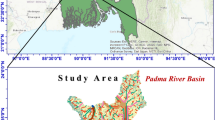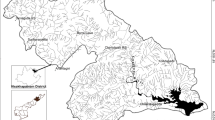Abstract
Sǎrǎţel River basin, which is located in Curvature Subcarpahian area, has been facing an obvious increase in frequency of hydrological risk phenomena, associated with torrential events, during the last years. This trend is highly related to the increase in frequency of the extreme climatic phenomena and to the land use changes. The present study is aimed to highlight the spatial and quantitative changes occurred in surface runoff depth in Sǎrǎţel catchment, between 1990–2006. This purpose was reached by estimating the surface runoff depth assignable to the average annual rainfall, by means of SCS-CN method, which was integrated into the GIS environment through the ArcCN-Runoff extension, for ArcGIS 10.1. In order to compute the surface runoff depth, by CN method, the land cover and the hydrological soil classes were introduced as vector (polygon data), while the curve number and the average annual rainfall were introduced as tables. After spatially modeling the surface runoff depth for the two years, the 1990 raster dataset was subtracted from the 2006 raster dataset, in order to highlight the changes in surface runoff depth.
Similar content being viewed by others

References
Gaume E., Livet M., Desbordesc M., Villeneuve J.-P., Hydrological analysis of the river Aude, France, flash flood on 12 and 13 November 1999, Journal of Hydrology, 286, 2004, 135–154
Pradhan B, Youssef A. M., A 100-year maximum flood susceptibility mapping using hydrological and hydrodynamic models: a case study, Journal of Flood Risk Management, 4,(3), 2011, 189–202
Youssef, A., Pradhan, B., Hassan, A. M., Flash flood risk estimation along the St. Katherine road, southern Sinai, Egypt using GIS based morphometry and satellite imagery, Environmental Earth Sciences, 62, 2011, 3, 611–623
Smith G., Flash Flood Potential: Determining the Hydrologic Response of FFMP Basins to Heavy Rain by Analyzing Their Physiographic Characteristics, 2003, http://www.cbrfc.noaa.gov/papers/ffp_wpap.pdf
Zaharia L., Minea G., Ioana-Toroimac G., Barbu R., Sârbu I., Estimation of the Areas with Accelerated Surface Runoff in the Upper Prahova Watershed (Romanian Carpathians), 2012, http://balwois.com/2012/USB/papers/595.pdf
Prǎvǎlie R., Costache R., The analysis of the susceptibility of the flash-floodsÊij genesis in the area of the hydrographical basin of Bâsca Chiojdului river, Forum Geografic, 2014, XIII, 1. Available online. DOI:10.5775/fg/2067-4635.2014.071.i
Minea G., Assessment of the Flas-Flood Potential of Basca River Catchment (Romania) based on Physiographic Factors, Central European Journal of Geosciences 5,(3), 2013, 449 1–10
Kumar Pramod, Tiwart K. N., Pal D. K., Establishing SCS Runoff Curve Number from IRS Digital Data Base, Journal of the Indian Society of Remote Sensing, 19(4), 1991, 245–252
Mack Mary J., HER-Hhydrologic evaluation of runoff; The Soil Conservation Service Curve Number technique as an interactive computer model, Computers & Geosciences, 21(8), 1995, 929–935
Scozzafava M., Tallini M., Net Infiltration in the Gran Sasso Massif of Central Italy using Thornthwaite water budget and curve-number method, Hydrogeology Journal, 9(5), 2001, 461–475
Xiaoyong Z., Min-Lang H., ArcCN-Runoff: an ArcG.I.S. tool for generating curve number and runoff maps, Environmental Modelling & Software, 2004, XX
Duncan O. J., Tollner E. W., Ssegane H., McCutcheon S. C., Curve Number approaches to estimate drainage from a Yard Waste Composting Pad, Applied Engineering in Agriculture, 29(2), 2013, 201–208
Al-Hasan A. A. S., Mattar Y. E-S., Mean runoff coefficient estimation for ungauged streams in the Kingdom of Saudi Arabia, Arabian Journal of Geosciences, 2013, Available online, DOI:10.1007/s12517-013-0892-7
Mahmoud S. H., Mohammad E. S., Alazba A. A., Determination of potential runoff coefficient for Al-Baha Region, Saudi Arabia using GIS, Arabian Journal of Geosciences, 2014, Available online, DOI:10.1007/s12517-014-1303-4
Haidu I., Crǎciun, A. I., Bilasco S., The SCS-CN model assisted by G.I.S — alternative estimation of the hydric runoff in real time, Geographia Technica, 2(1), 2007, 1–7
Bilasco S., Implementarea GIS Ãon modelarea viiturilor pe versanti, Casa Cǎrtii de Stiintǎ Cluj-Napoca, 2008
Minea G., Bazinul hidrografic al râului Bâsca — Studiu de hidrogeografie, tezǎ de doctorat, Universitatea din Bucureşti, Facultatea de Geografie, Bucureşti, 2011
Gyory Maria-Mihaela, Haidu I., Unit hydrograph generation for the ungauged subwatershed in the Monroştia Basin, Geographia Technica, 6(2), 2011, 23–29
Domniţa M., Runoff modeling using GIS. Application in torrential basins in the 591 Apuseni Mountains, Ph.D Thesis, Cluj Napoca. 2012
Costache R., Using GIS techniques for assessing Lag time and Concentration time in small river basins. Case study:Pecineaga river basin, Romania, Geographia Technica, 9(1), 2014, 31–38
Elbialy S., Mahmoud A., Pradhan B., Buchroithner M., Application of spaceborne SAR data for extraction of soil moisture and its use in hydrological modelling at Gottleuba Catchment, Saxony, Germany, Journal of Flood Risk Management, 7(2), 2014, 159–175
Hernandez M., Miller S. N., Goodrich D. C., Goff B. F., Kepner W. G., Edmonds C. M., Jones K. B., Modeling runoff response to land cover and rainfall spatial variability in semi-arid watersheds, Environmental Monitoring And Assessment, 64, 2000, 285–298
Jetten V. G., LISEM User Manual. Utrecht Center for Environment and Landscape Dynamics, Utrecht University, Utrecht, 2002
Zhang Y., Wei H., Nearing M. A., Effects of antecedent soil moisture on runoff modeling in small semiarid watersheds of southeastern Arizona, Hydrological Earth System Science, 15(10), 2011, 3171–3179
Billa L., Assilzadeh H., Mansor S., Mahmud A. R., Ghazali A. H., Comparison of recorded rainfall with quantitative precipitation forecast in a rainfall-runoff simulation for the Langat River basin, Malaysia, Central European Journal of Geosciences, 3(3), 2011, 309–317
Hegedus P, Czigany S., Balatony L., Pirkhoffer E, Analysis of soil boundary conditions of flash-floos in a small basin in SW Hunhary, Central European Journal of Geosciences, 5(1), 2013, 97–111
Ghoneim E., Foody G., M., Assessing flash flood hazard in an arid mountainous region, Arabian journal of Geosciences, 6(4), 2013, 1191–1202
AlFugura A., Billa, L., Pradhan B., Mohamed T.A., Rawashdeh S., Coupling of hydrodynamic model and aerial photogrammetry-derived digital surface model for flood simulation scenarios using GIS: Kuala Lumpur flood, Malaysia, Disaster Advances, 4(4), 2011, 20–28
Garcia-Ruiz J.M., Lasanta T., Marti C., Gonzales C., White S., Ortigosa L., Flano P.R., Changes in Runoff and Erosion as a Consequence of Land-Use Changes in the Central Spanish Pyrenees, Physics and Chemistry of the Earth, 20(3), 1995, 301–307
Haverkamp S., Fohrer N., & Frede H.G., Assessment of the effect of land use patterns on hydrologic landscape functions: a comprehensive GIS based tool to minimize model uncertainty resulting from spatial aggregation, Hydrological Processes, 19(3), 2005, 715–727
Hernández-Guzmán R, Ruiz-Luna A, & Berlanga-Robles CA., Assessment of runoff response to landscape changes in the San Pedro subbasin (Nayarit, Mexico) using remote sensing data and GIS, Journal of Environmental Science and Health, Part A: Toxic/Hazardous Substances and Environmental Engineering, 43(12), 2008, 1471–1482
Descroix L., Esteves M., Souley Yéro K., Rajot J.-L., Malam Abdou M., Boubkraoui S., Lapetite J. M., Dessay N., Zin I., Amogu O., Bachir A., Bouzou Moussa I., Le Breton E., Mamadou I., Runoff evolution according to land use change in a small Sahelian catchment, Hydroogy and Earth System Scences, 8(1), 2011, 1569–1607
Costea G., Deforestation process consequences upon surface runoff coefficients. Catchment level case staudy from the Apuseni Mountains, Romania, Geographia Technica, 8(1), 2013, 28–33
Costache R., Fontanine I., Land use changes in the Subcarpathian area between Buzau and Slanic rivers, during 1990–2006 and their consequnces on surface runoff, Riscuri si catastrofe, 13(2), 2013, 171–182
Drobot R., Metodologie de determinare a bazinelor hidrografice torentiale Ãőn care se aflǎ aşezǎri umane expuse pericolului de viituri rapide, Contract de Cercetare, Universitatea Tehnicǎ de Construcţii, Bucureşti, 2007
Pisota I., Zaharia Liliana & Diaconu D., Hidrologie (Ediţia a II-a revizuitǎ şi adǎugitǎ), Editura Universitarǎ Bucureşti, Bucureşti, 2010
Arghiriade C., Rolul hidrologic al padurii. Editura Ceres, Bucharest, 1977
Engineering Staff. National Engineering Handbook. USDA-NRCS, Engineering Division. U.S. Gov. Print. Office, Washington DC, Part 630, Section 4, Chapter 7, 2007
Ponce V. M., Hawkins R. H., Runoff curve number: has it reached maturity, Journal of Hydrologic Engineering, 1(1), 1996, 11–19
Dawod G. M., Mirza M. N., Al-Ghamdi K. A., Assement of several flood estimation methodologies in Makkah metropolitan area, Saudi Arabia, Arabian Journal of Geoscience, 6(3), 2013, 985–993
Masoud A. A., Runoff modeling of the wadi system for estimating flash-flood and groundwater recharge potential in Southern Sinai, Egypt, Arabian Journal of Geoscience, 4(5–6), 2011, 785–801
Abdel-Latif A., Sherief Y., Morphometric analysis and flash-floods of Wadi Sudr and Wadi Wardan, Gulf of Suez, Egypt: using digital elevation model, Arabian Journal of Geoscience, 5(2), 2012, 181–195
Corine Land Cover (2006), raster data, European Environment Agency (eea.europa.eu)
The soils map in electronic format, 1:200,000, ICPA Bucureşti
National Meteorological Administration, 2013
National Institute of Hydrology and Water Management, 2011
Author information
Authors and Affiliations
Corresponding author
About this article
Cite this article
Romulus, C., Iulia, F. & Ema, C. Assessment of surface runoff depth changes in Sǎrǎţel River basin, Romania using GIS techniques. cent.eur.j.geo. 6, 363–372 (2014). https://doi.org/10.2478/s13533-012-0181-0
Received:
Accepted:
Published:
Issue Date:
DOI: https://doi.org/10.2478/s13533-012-0181-0



